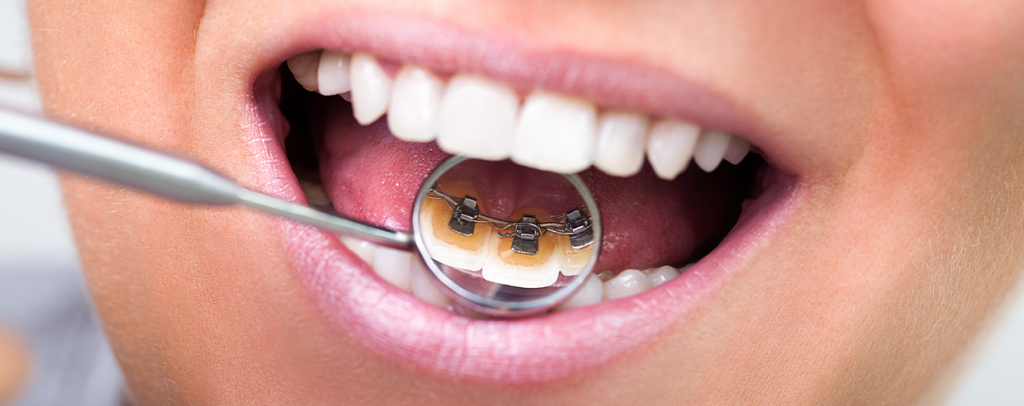If you are one of those who are looking for an alternative to traditional braces, you have surely heard of the lingual braces procedure, also known as "hidden braces". Lingual braces have gained great popularity among orthodontic procedures in recent years. The main reason for this is that they are both as good as traditional …
If you are one of those who are looking for an alternative to traditional braces, you have surely heard of the lingual braces procedure, also known as “hidden braces”.
Lingual braces have gained great popularity among orthodontic procedures in recent years. The main reason for this is that they are both as good as traditional treatments in straightening your teeth and are undoubtedly very aesthetically satisfying. But what do you know about hidden braces?
Lingual braces are placed at the back of your teeth. This is what makes the procedure stand out the most. You will notice this immediately when you see someone wearing conventional braces. This procedure is almost impossible to notice from the outside. After reading the article, you can contact Tower Dental for more detailed information and to make an appointment.
Who Is Suitable For Lingual Braces?
Lingual braces can effectively address a wide range of orthodontic issues, including crooked teeth, misaligned bites (overbite, underbite, crossbite), and other alignment issues. They are placed on the inner side of the teeth, making them virtually invisible from the outside. This makes them an excellent choice for individuals who may feel self-conscious about wearing traditional braces.
Hidden braces can be suitable for individuals of various ages, including adults and teenagers. Adults, in particular, may choose lingual braces to avoid the visibility of traditional ones. If you’re looking for a less noticeable alternative for teeth straightening, lingual braces might be the right choice for you. They provide effective orthodontic treatment while maintaining a more inconspicuous appearance.
What Are The Advantages of Lingual Braces?
Lingual braces offer several advantages for individuals seeking orthodontic treatment. The most important ones are listed below:
- Aesthetic appearance
- Comfortable to use
- Customization
- Improving speech
- Troubleshooting orthodontic problems
Besides these benefits, consulting with an orthodontist is essential to determine if lingual braces are the right choice for your specific orthodontic needs and personal preferences. The specialist assesses your dental condition, considers your preferences, and helps you decide the most suitable treatment option.
What Is The Lingual Braces Procedure?
The procedure for getting lingual braces generally involves several steps. Firstly, a consultation with an orthodontist is necessary to determine if lingual braces are the right option for your specific orthodontic needs. During this initial appointment, the orthodontist examines the teeth and discusses with you the treatment plan.
Once the decision is made to proceed with lingual braces, the orthodontist takes impressions or digital scans of your teeth. These impressions are used to create customized brackets and wires that will be fitted on the inner side of the teeth. The next step involves the actual placement of your lingual braces. This process requires careful precision, as each bracket is bonded to the back of the teeth. Once the brackets are in place, archwires are threaded through them and secured with small bands.
You may experience some initial discomfort or speech adjustments as they adapt to the presence of lingual braces. Regular follow-up appointments with your orthodontist are essential to monitor progress and make any necessary adjustments to the braces. Throughout the treatment period, which can vary based on individual needs, you are advised to maintain good oral hygiene practices and attend scheduled orthodontic check-ups. After the desired tooth alignment is achieved, your lingual braces are removed, and a retainer may be recommended to prevent teeth from shifting back.
What Awaits Me After Choosing Lingual Braces?
Caring for lingual braces involves a series of specific steps to ensure effective treatment and the overall well-being of your oral health. Firstly, maintain a diligent oral hygiene routine by brushing your teeth after each meal and snack. Use a soft-bristled toothbrush and fluoride toothpaste to thoroughly clean around your braces, preventing the buildup of plaque.
Incorporate daily flossing into your routine to reach areas between the teeth and under the braces. Special tools like floss threaders or interdental brushes can be useful for navigating around them. In case of any irritation or discomfort caused by the braces, you may apply orthodontic wax to smooth edges and reduce friction against the cheeks and tongue after approval of your dentist.
Be mindful of your diet, avoiding foods that could potentially damage the braces. Cut large or hard items into smaller, manageable pieces, and steer clear of sticky, hard, or overly crunchy foods. Regularly attend orthodontic check-ups with your orthodontist for adjustments and progress monitoring. During these appointments, communicate any concerns or issues you may be experiencing. Remember that if you apply the right care, you can get excellent results from the procedure. Contact Tower Dental for Turkey lingual braces prices and more.








